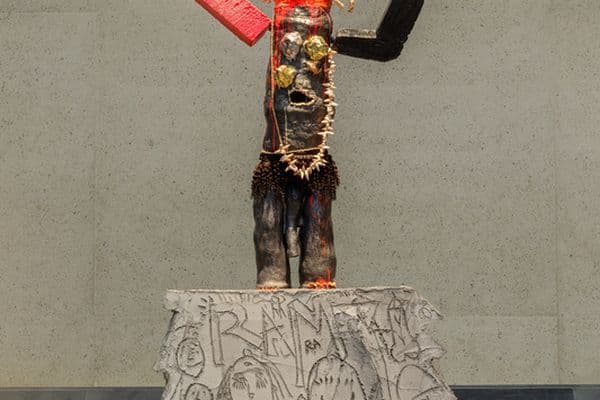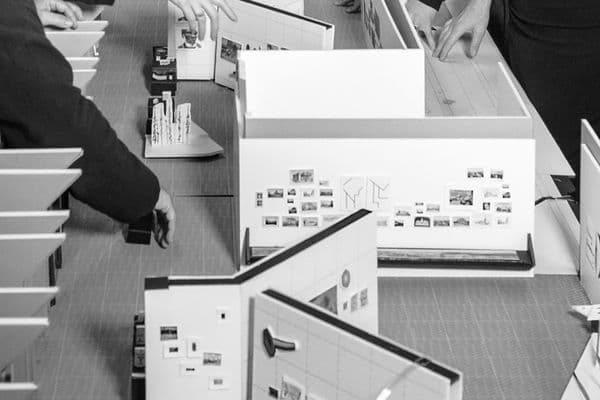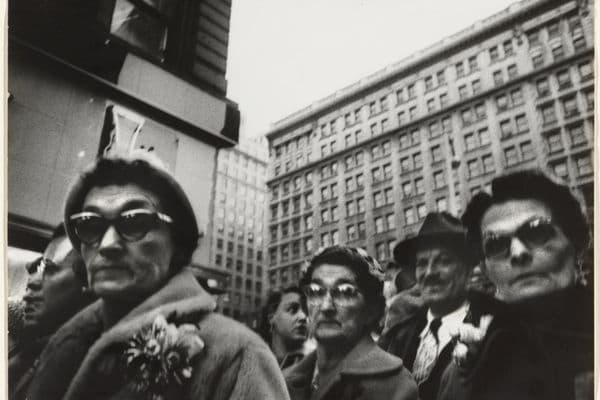Wall to Wall
Collecting at the National Gallery of Australia
14 Oct 1998 – 28 Jan 1999

Martin Sharp and Tim Lewis The unexpected answer (Yellow House) 1973 National Gallery of Australia. Gift of the Philip Morris Arts Grant 1982
About
Bizarre, eccentric, eclectic, mind-boggling, idiosyncratic: Wall to Wall examines the variety of works that the National Gallery of Australia collects and the ways that they are displayed. Wall to Wall is intended to underscore the depth, diversity and beauty of the National Collection.
The works on display in a museum are like the tip of an iceberg: only a small part is visible, with the bulk of the collection out of sight. Many of the works in Wall to Wall are unfamiliar exhibits, which have appeared infrequently on the walls. These works have been taken from the Gallery's repository or store house. It is popularly assumed that this is either a graveyard for unfashionable works or, alternatively, that it is an Aladdin's cave of undiscovered treasures. The reality is far more prosaic.
Computerised cataloguing ensures that details of all works in a collection are known and listed. All of the National Gallery's collection is listed online. The works in store provide support for the collection on the walls. The store is called upon for theme exhibitions or to substitute for works on loan. Using the works in storage, the output of the most influential artists can be seen in depth, as with Arthur Boyd, Australia's most important living artist, whose work is displayed in this exhibition. Works on paper, because they are changed regularly to minimise deterioration caused by light, are also plentiful among the collection in storage.
Wall to Wall draws on all major areas covered by the National Gallery of Australia's collection policy and includes Indigenous Australian and Australian art, European, American, Asian and African art in diverse media. More works of art than have ever been seen at any one time will be on display in the new exhibition galleries in a deliberately eclectic and dense display – as the name Wall to Wall suggests. The display is divided into five zones, each to feature a particular way of collecting.
The first area will include works from the Max Ernst Collection, acquired by the Gallery in 1985. Ernst was a noted member of the Surrealists. He collected tribal art from North America, Africa and the Pacific region. The display also includes a collage and prints by Ernst, making clear the similarities and differences between the works he made and the works he collected. The presence of Ernst's works will stamp this area with the authority of the artist as collector.
Corporate patronage has provided the Gallery with another very rich collection. Wall to Wall includes selections from the Philip Morris Collection which were purchased for the Gallery between 1973 and 1988. This extensive body of work defines a particularly inventive and productive period in the history of Australian art, the seventies and early eighties. The range of photographs, paintings, prints and sculpture documents the work of emerging artists and contemporary trends, always a risky business. The works of many noted artists were acquired, giving the Gallery perhaps the best representation in Australia of this period.
A room is set aside for the work of a major artist collected in depth – in this case, Arthur Boyd. The biggest collection area in the National Gallery is devoted to Australian art. The Gallery uses its collection to tell the story of Australian art in all its complexity and, simultaneously, shows the evolution of the major artists within that narrative. How (and why) artists are collected in depth is visible in the intertwined themes of the compassion and social conscience of Arthur Boyd, teased out in a display of his paintings, drawings, prints and sculpture. The display will showcase 80 works drawn from the Arthur Boyd Gift to the National Gallery, which comprises about 2500 items spanning more than 40 years of the artist's work from 1934 to 1975.
A collection built around an art movement can be seen in the room devoted to Pop art and its legacy. The paintings and prints by Australian and international artists demonstrate how a museum collection defines an historical period. The hot sexuality of Richard Larter's paintings is contrasted with the New York 'cool' of Andy Warhol's portraits of Mao Tse-Tung. The mediated images acknowledge the influence of television and photography as the prime influences on how we view our world in the electronic age. This room is charged with the unrepentant optimism and boisterous energy of the sixties.
Public understanding of the arts is largely informed by the logical narrative of the textbook or museum exhibition. Not all displays need to be serious, however. The fifth room attacks such rational displays, celebrating a decorator taste. Here art has been chosen 'to match the lounge suite'. Everything is red: paintings, prints, sculpture, ceramics and costumes. The works are hung cheek by jowl, jostling for the viewer's eye.
In addition to the works on display, curators will show works to the public directly from solander boxes at advertised times throughout the period of the exhibition. The solander boxes will be chosen to indicate the range of works on paper from all parts of the collection. The attention given to preserving the works in the collection will be evident in a conservation display. The Conservation Department will show aspects of the varied duties that they perform for the Gallery – for example, arranging the packing of works to be transported. The crates in which works have been transported to exhibitions nationally and internationally will also be on display. A varied and challenging public program has been designed to work in tandem with the concepts announced by the exhibition and will include talks by noted Australian artists, collectors and dealers.
"It was very late before we would admit we were collectors."
The famous American collector, Dominique de Menil's confessional statement makes collecting sound like a secret vice. Collecting is a passion and an obsession. While the idea of collections and collecting forms the central concept for Wall to Wall, at the core is the sheer aesthetic delight and wonder of works of art. This is the ultimate rationale for collecting, as witnessed in Wall to Wall.
Text sourced from: Wall to Wall Observer : An Exhibition of Hundreds of Works of Art from the National Gallery of Australia Storage Areas : Exhibition Galleries, 14 October 1998–26 January 1999/ National Gallery of Australia. Canberra: National Gallery of Australia, 1998.











